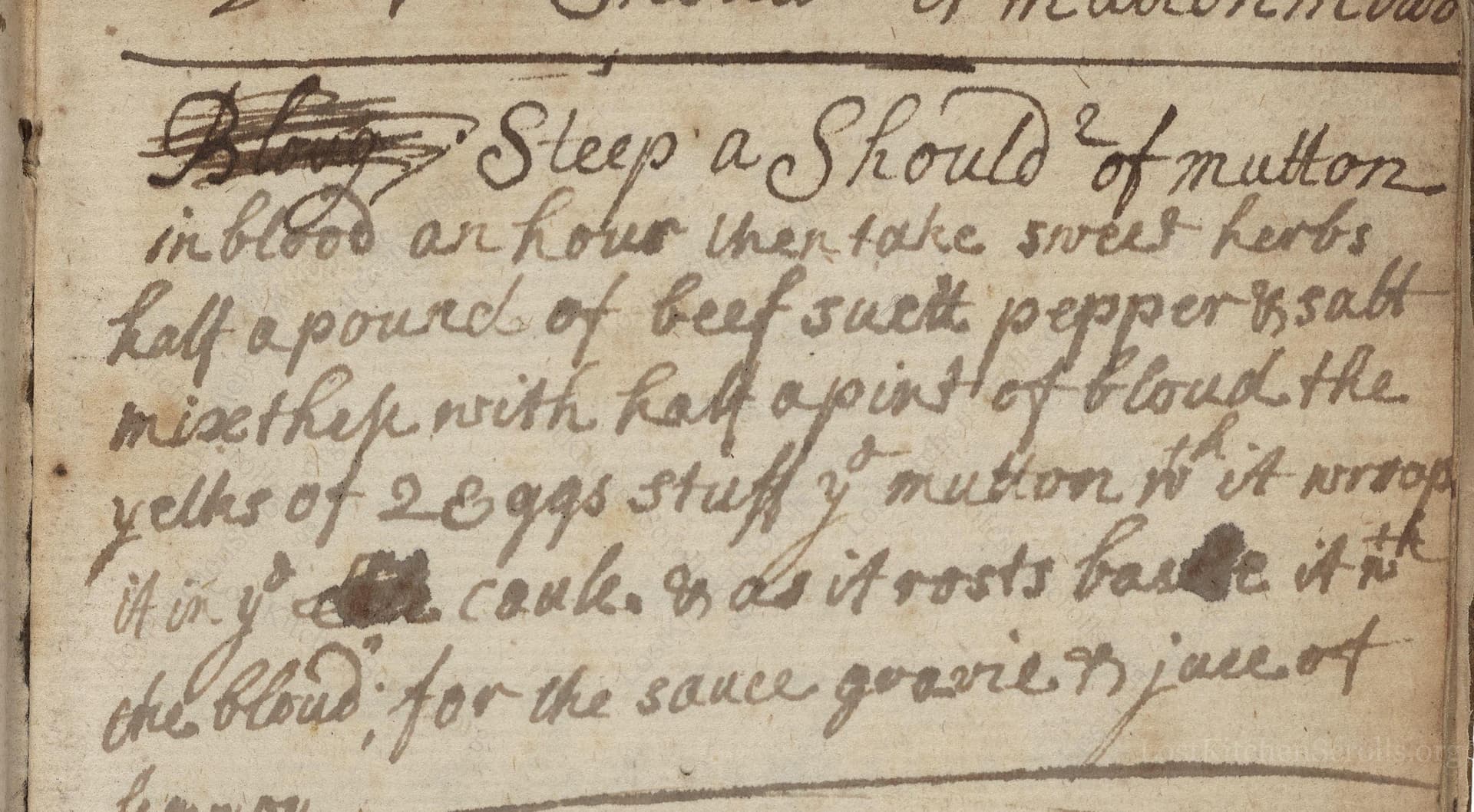Steep A Should Of Mutton In Blood
From the treasured pages of Medicinal and cookery recipes of Mary Baumfylde
Written by Mary Baumfylde

Steep A Should Of Mutton In Blood
"Steep a Should^r of mutton in blood an hour then take sweet herbs half a pound of beef suett pepper & salt mix these with half a pint of blood the yelks of 2 eggs stuff y^e mutton w^th it wropp it in y^e caul & as it rosts baste it w^th the blood: for the sauce gravie & juce of lemmon."
Note on the Original Text
The original recipe uses idiosyncratic 17th and 18th-century English spelling—'Should^r' for 'shoulder', 'stuff y^e mutton w^th it' for 'stuff the mutton with it', and abbreviations like 'y^e' for 'the', 'w^th' for 'with'. Instructions were brief and relied on assumed kitchen knowledge, omitting precise times or temperatures, as cooks were expected to adjust by look and feel. Notably, the recipe integrates both preparation and sauce finishing in a fluid stream, which was typical of manuscript cookery at the time.

Title
Medicinal and cookery recipes of Mary Baumfylde (1626)
You can also click the book image above to peruse the original tome
Writer
Mary Baumfylde
Era
1626
Publisher
Unknown
Background
A sumptuous journey into early 17th-century English cookery, this delightful volume offers a tantalizing glimpse into the recipes, flavors, and culinary secrets that once graced aristocratic tables. Prepare for a taste of history, presented with wit and wisdom!
Kindly made available by
Folger Shakespeare Library
This recipe hails from an early modern English manuscript dating between 1626 and 1702–1758, attributed to Mary Baumfylde. During this period, blood was a prized culinary resource, commonly used to enrich stuffings and sauces, particularly in rural and noble households where no part of the animal was wasted. The inclusion of fresh herbs and caul fat reflects both the sophistication and the resourcefulness of historical English cookery. The manuscript itself likely belonged to an upper-class or gentry household, where complex roasts such as this would have graced the banquet table.

In its original form, this dish would have been prepared in a large manor kitchen, using heavy iron knives for butchering and chopping, a wooden trencher or board for mixing, and a spit with a hearth or open-fire oven for roasting. Basting brushes made from bundled herbs and large ladles were used to apply blood during roasting. Caul fat would have been sourced from fresh butchery on site, and lemon juice extracted by hand.
Prep Time
1 hr 30 mins
Cook Time
2 hrs 30 mins
Servings
8
We've done our best to adapt this historical recipe for modern kitchens, but some details may still need refinement. We warmly welcome feedback from fellow cooks and culinary historians — your insights support the entire community!
Ingredients
- 1 shoulder of mutton (4 1/2–5 1/2 lb, or substitute lamb shoulder)
- 1 pint fresh animal blood (pork or beef blood, or substitute blended beetroot juice for vegetarian version)
- 2 oz mixed sweet herbs (parsley, marjoram, thyme)
- 8 oz beef suet (or substitute grated beef fat or cold unsalted butter)
- 2 egg yolks
- Salt, to taste
- Freshly ground black pepper, to taste
- 1 cup animal blood (additional, for stuffing and basting)
- 1 piece caul fat (about 9 oz, pork caul or substitute baking parchment/cheesecloth)
- Juice of 1 lemon
Instructions
- Begin by soaking a whole shoulder of mutton (about 4 1/2 to 5 1/2 lb) in 1 pint of fresh animal blood for one hour.
- Meanwhile, finely chop 2 oz of mixed fresh sweet herbs (such as parsley, marjoram, and thyme) and 8 oz of beef suet.
- Mix these with a generous pinch each of salt and freshly ground black pepper, then add 1 cup of animal blood and the yolks of 2 eggs.
- Combine well.
- Carefully cut pockest or make small slits in the mutton and stuff this mixture inside.
- Wrap the shoulder with a layer of caul fat (pork caul if avaiable) to secure the stuffing and keep the meat moist during roasting.
- Roast in a preheated oven at 350°F, basting regularly with some of the reserved blood.
- For the sauce, deglaze the roasting pan with meat juices and finish with a good squeeze of fresh lemon juice before serving.
Estimated Calories
730 per serving
Cooking Estimates
Preparing this dish takes about 30 minutes to chop, mix, and stuff the meat, with an extra hour for soaking. The mutton roasts for about 2.5 hours to become tender and develop flavor. Each serving will be hearty and rich, providing a full meal for 8 people, and the calories include both the meat and the stuffing.
As noted above, we have made our best effort to translate and adapt this historical recipe for modern kitchens, taking into account ingredients nowadays, cooking techniques, measurements, and so on. However, historical recipes often contain assumptions that require interpretation.
We'd love for anyone to help improve these adaptations. Community contributions are highly welcome. If you have suggestions, corrections, or cooking tips based on your experience with this recipe, please share them below.
Join the Discussion
Rate This Recipe
Dietary Preference
Main Ingredients
Culinary Technique
Occasions

Den Bockfisch In Einer Fleisch Suppen Zu Kochen
This recipe hails from a German manuscript cookbook compiled in 1696, a time whe...

Die Grieß Nudlen Zumachen
This recipe comes from a rather mysterious manuscript cookbook, penned anonymous...

Ein Boudain
This recipe comes from an anonymous German-language manuscript cookbook from 169...

Ein Gesaltzen Citroni
This recipe, dating from 1696, comes from an extensive anonymous German cookbook...
Browse our complete collection of time-honored recipes



